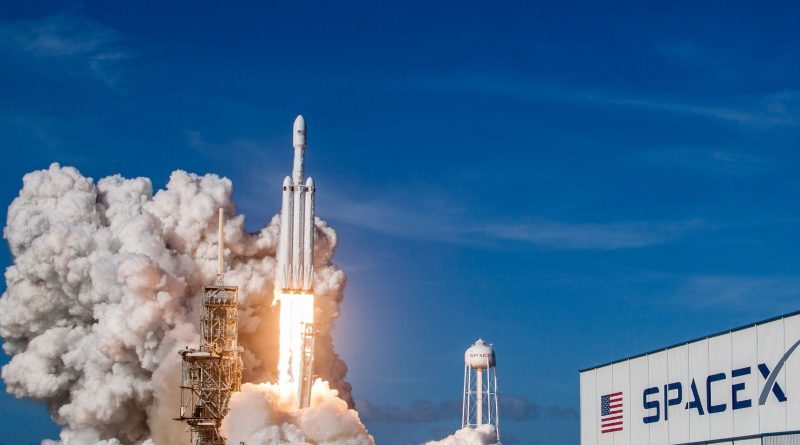Successful Falcon Heavy Test Flight: “Starman” Reaches Orbit, 2/3 Rocket Cores Recovered
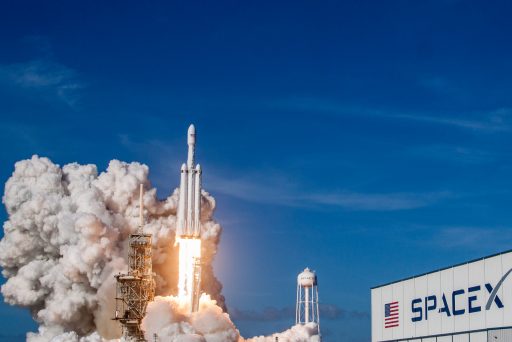
The stakes were high for SpaceX on Tuesday when their triple-core monster rocket leapt off from Florida’s Space Coast on an ambitious shakedown mission that held many unknowns for the California-based company.
Many had thought it impossible just a few short years ago, but SpaceX again beat the odds – even to the surprise of company leader Elon Musk – by successfully sending Falcon Heavy off into orbit and recovering two of its main boost stages in science-fiction-like fashion by flying them back to the Cape in near-simultaneous acrobatics.
Although SpaceX engineers spent countless hours poring over simulations to ensure Falcon Heavy would have the best possible chance at a successful debut, a number of open questions remained when the 1,420-metric-ton beast rumbled off its storied Kennedy Space Center launch pad. A tripling of acoustics and vibration over the Falcon 9, the potential of unforeseen dynamics between the three booster cores and their 27 engines, ice falling off the rocket’s second stage and punching holes in the side booster nose cones and the unknowns coming with separating two massive cores from the still-firing central stage were serious concerns when Falcon Heavy embarked on its long-delayed maiden flight.
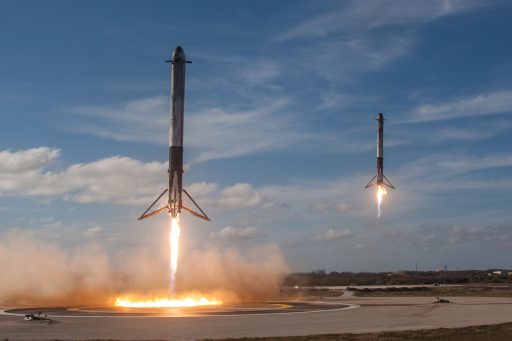
The roar of 27 Merlin engines engulfed Cape Canaveral at 20:45 UTC on Tuesday, 3:45 p.m. local time and many had descended onto the Space Coast to witness SpaceX take another major step on the company’s path to exploration and colonization of the solar system. The ground shook as Falcon Heavy officially became the most-powerful rocket in operation when rising from its historic launch pad that saw off all Apollo flights to the lunar surface and the majority of Space Shuttle missions.
Rising into clear skies, the 70-meter tall Falcon Heavy departed Cape Canaveral straight east to begin a complex mission profile eventually leading up to an Earth Departure Maneuver early Wednesday morning UTC to send its payload into deep space – a midnight-cherry Tesla Roadster from Musk’s personal collection, now ‘driven’ by a mannequin dressed in a SpaceX Space Suit, aiming for an elliptical orbit around the sun venturing out as far as the orbit of Mars, some 400 million Kilometers from Earth.
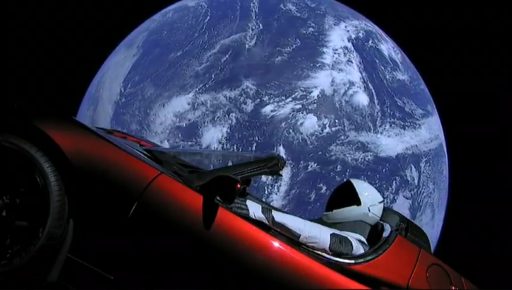
The first sigh of relief was breathed by the SpaceX workforce when Falcon Heavy passed the point of maximum stress on the used airframes of its flight-proven boosters and the reinforced central core. The twin boosters successfully departed the vehicle two and a half minutes after launch and went through near-simultaneous boost-back maneuvers to power back toward Cape Canaveral and land just 300 meters from one another in SpaceX’s Landing Zones 1 & 2 after an eight-minute round trip to the edge of space.
At the same time, around 350 Kilometers from shore, the 47-meter tall central core was on its final approach to SpaceX’s Drone Ship after separating from the climbing rocket at the three-minute mark into the flight, handing off to the second stage for the boost into orbit. SpaceX was only able to 2-for-3 in rocket landings on Tuesday as the Center Core crashed into the Ocean after running out of igniter fluid for its three-engine landing burn – only a little tarnish on an otherwise spectacularly successful day.
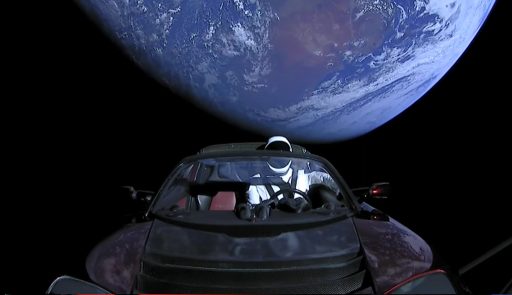
After the incredibly fast pace of first stage flight and having four separate free-flying Falcon Heavy stages heading toward their destination points, it was up to the rocket’s second stage to finish the job of pushing “Starman” and its Tesla into solar orbit. The MVac-powered stage completed an initial five-and-a-half-minute burn into a Low Earth Orbit and a thirty-second re-light over Sub-Saharan Africa pushed the stack into an elliptical orbit where it was to complete two laps around Earth before the experimental departure maneuver to head off into Deep Space.
This engine burn aims to accomplish two objectives at once: 1) sending the Tesla off into its solar orbit in one of the most elaborate cross-brand marketing campaigns ever and, 2) qualify the Falcon Heavy & Falcon 9 second stage for long-coast missions like direct Geostationary Injections to allow the vehicles to compete for Department of Defence missions. Confirmation of successful Earth departure of the electric sports car will come directly through SpaceX after the maneuver is completed in the wee hours UTC on Wednesday.
Third burn successful. Exceeded Mars orbit and kept going to the Asteroid Belt. pic.twitter.com/bKhRN73WHF
— Elon Musk (@elonmusk) February 7, 2018
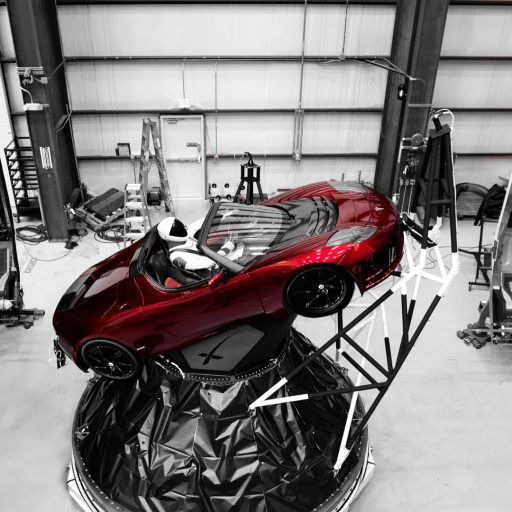
As the payload for Falcon Heavy’s high-risk mission, Musk picked one of his used Tesla Roadsters to shoot off into the Solar System instead of opting for the “boring” dummy payloads like concrete or metal boilerplates that were part of the maiden flights of vehicles preceding SpaceX. To add to the fun in true SpaceX style, the company placed a mannequin wearing a space-qualified SpaceX suit in the car’s driver’s seat, one arm on the wheel, the other hanging out the window.
Named “Starman” in homage to the famous 1972 David Bowie song, the figure traveled into the cosmos while Bowie’s “Space Oddity” was playing on the radio and the car’s glove compartment contained a copy of “The Hitchhiker’s Guide to the Galaxy” and a towel saying ‘Don’t Panic’.
“I love the thought of a car drifting apparently endlessly through space and perhaps being discovered by an alien race millions of years in the future,” Musk Tweeted in December.
Accelerating the 1,300-Kilogram sports car to a top speed of 11 Kilometers per second did not come close to exhausting Falcon Heavy’s potential performance, allowing for all three boosters to be returned to Earth intact and the second stage to perform a less-than-optimal flight trajectory to facilitate the long coast test. The car’s final orbit had been set up to precess between Earth and Mars without interfering with Earth’s neighboring planet for hundreds of millions of years to come in order to comply with planetary protection guidelines.
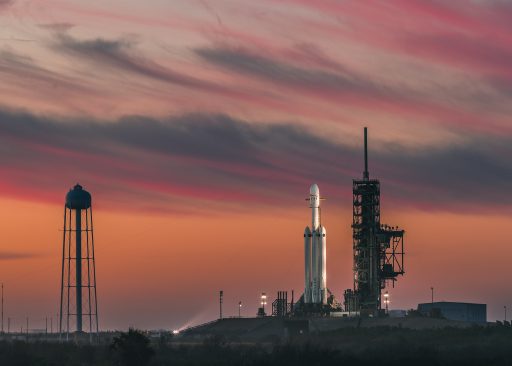
The maiden launch of Falcon Heavy was widely regarded as one of the most-anticipated spaceflight events of 2018 and many traveled to the Kennedy Space Center to witness the powerful rocket take to the skies and watch the side boosters descend toward their near-simultaneous landing, in the process sending a pair of dual sonic booms across the Space Coast.
Popular viewing locations like Jetty Park were reported at capacity over three hours before the opening of the rocket’s launch window and Kennedy’s press site was buzzing like it last did for the Shuttle’s final launches in 2010 and 2011. Weather was fair for an afternoon of launch watching with temperatures of 24°C, mostly clear skies and calm winds – also creating very favorable conditions for Falcon Heavy to get off the pad – barring any technical gremlins that usually come up when new rockets are involved.
With the massive launch vehicle assembled in December, SpaceX went through a series of Wet Dress Rehearsals in January, culminating in a successful Static Fire Test on the 24th that delivered a wealth of data on the performance of the 27 Merlin engines and the structural interplay of the three cores. The tanking tests and Static Fire were also designed to iron out any teething issues with the launch vehicle and the revamped ground system at LC-39A in a bid to avoid surprises on the technical side come launch day,
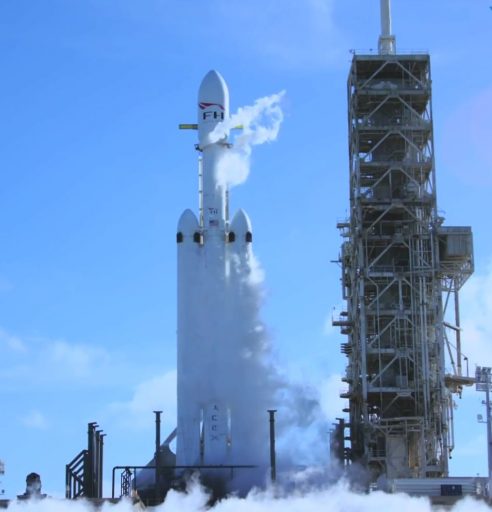
Towering above Launch Complex 39A, Falcon Heavy entered a lengthy countdown operation Tuesday morning when power was applied to the vehicle for a methodical checkout campaign – giving Launch Controllers plenty of work as four sets of avionics had to be checked out and configured for flight. No issues were reported from the vehicle side and the launch pad was cleared two hours before the opening of the day’s two-and-a-half-hour launch window.
However, liftoff had to be pushed over two hours into the day’s 2.5-hour window to wait for sporty winds aloft to calm down and create a more benign flight environment for the untried rocket. Balloon data showed the favorable trend for upper level winds and teams at two Launch Control Rooms at the Cape and engineering support at SpaceX HQ in Hawthorne provided a unanimous GO to allow the countdown to be handed over to computers for the 85-minute automated countdown sequence facilitating the complex tanking operation to load the vehicle with over 1,300 metric tons of rocket-grade Kerosene and Liquid Oxygen.
Tanking was by the book, starting with loading the three cores and upper stage with over 400 metric tons of Rocket Propellant 1, chilled to -7°C, before the sub-cooled LOX at -207°C was pumped into the rocket in rapid fashion as over 935 metric tons had to be loaded as close to T-0 as possible to ensure the maximum possible performance was available. Propellant loading closed out in the last three minutes of the countdown by which point the Falcon Heavy had completed final exercises of its propellant trim valves, switched to internal power, armed its destruct system and was disconnected from its supporting Strongback.
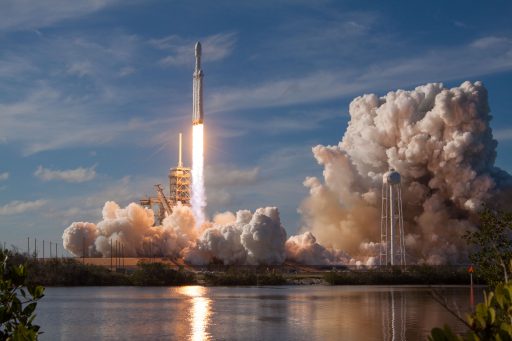
Falcon Heavy’s triple-redundant flight computers assumed control of the countdown at the one-minute mark and the Launch Director declared a final GO just inside T-30 seconds. Ignition of Falcon Heavy’s 27 Merlin 1D main engines was commanded at T-5 seconds, lighting them in pairwise fashion to prevent thrust torques from building up and ripping the vehicle apart right on the pad – one of the biggest fears for SpaceX founder and CEO Elon Musk who stated multiple times that getting the vehicle off the pad “would be a win.”
And off the pad it went – Liftoff occurred at 20:45:00.49 UTC and Falcon Heavy ascended vertically to clear the 106-meter tall Fixed Service Structure left behind from the Space Shuttle with a total thrust of 2,140 metric-ton-force. Although the most powerful rocket in service today – both in terms of launch thrust and lift capability – Falcon Heavy is only the third-most-powerful rocket to launch from Kennedy’s LC-39A after the mighty Saturn V and the Space Shuttle with its Solid Rocket Booster assistance.
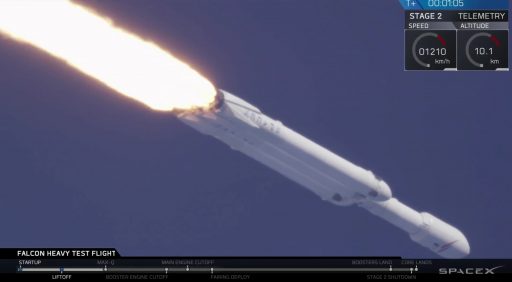
Spreading its wings, Falcon Heavy completed its pitch and roll maneuvers into a knife-edge orientation, burning over seven metric tons of propellant every second of powered flight between the three cores. Launch Controllers called out Mach 1 at one minute and seven seconds into the mission and Falcon Heavy throttled back on all three of its cores as it passed Maximum Dynamic Pressure at 82 seconds into the flight.
Falcon Heavy braved the stress encountered at MaxQ and the two Side Boosters throttled back up to full thrust while the Center Core remained in partial thrust mode to save propellants for later on. The twin boosters throttled down from T+2:10 until shutting down their Merlin engines two minutes and 30 seconds into the flight after helping Falcon Heavy accelerate to 1.9 Kilometers per second.
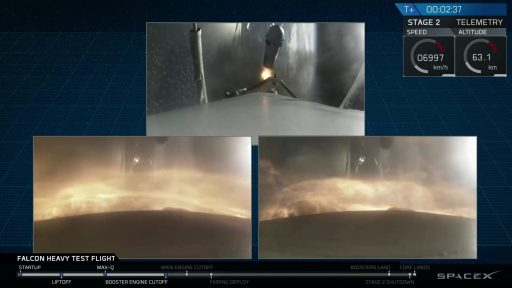
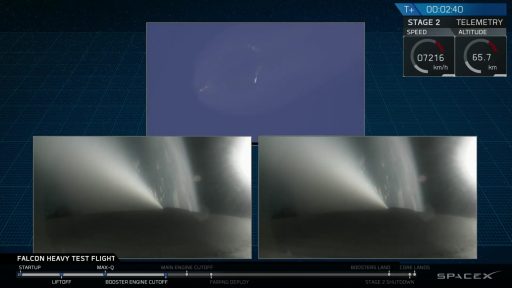
BECO was called out by the launch team and was followed by one of the most critical moments of Falcon Heavy’s shakedown flight as the separation systems of the boosters could not be fully tested on the ground and concerns had lingered that there was a possibility of re-contact after separation. Onboard video from the Central Core and the two side-mounted boosters showed them falling away from the core at an altitude of 61 Kilometers with each departing booster receiving a slight blasting from the core’s engine exhaust.
Relying on their Nitrogen thrusters, the two boosters entered their acrobatic tour de force with a swift flip maneuver to point their engines toward the direction of travel and not waste precious time as every second carried them further away from the Space Coast. They each fired up three engines in staggered fashion at T+2 minutes and 50 seconds on a long boost back maneuver of one minute and 25 seconds.
MECO – Main Engine Cutoff on the Center Core was confirmed three minutes and 5 seconds into the flight after it boosted the vehicle to an altitude of 86 Kilometers and a velocity of 2.65 Kilometers per second. The two stages parted ways five seconds later via four pneumatic pushers with the second stage immediately heading into start-up mode and the Central Core using its interstage thrusters to flip around for its partial boostback maneuver of nearly one minute, starting at T+3:26 to slow the booster for a more manageable re-entry and to limit its downrange travel distance from the Cape. Booster 1033 was aiming for the Drone Ship ‘Of Course I Still Love You’ holding position 345 Kilometers from the launch pad – set for SpaceX’s 14th recovery attempt at sea, the first since last October.
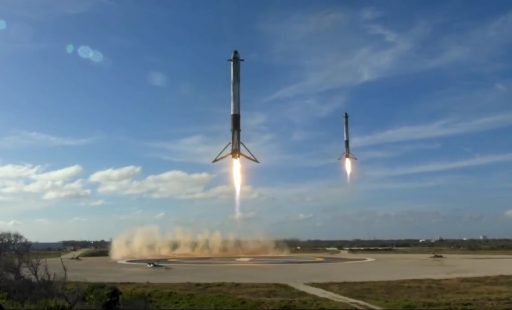
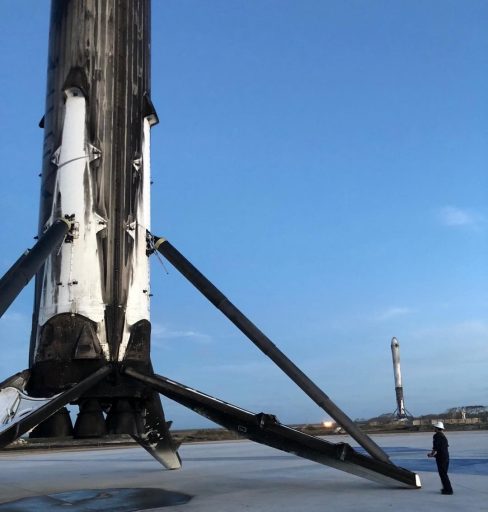
For the two Side Boosters, flight continued in synchronized fashion, deploying their grid fins at the five-minute mark, passing the high point of their trajectory and falling back toward the dense atmosphere for a 14-second re-entry burn starting at T+6 minutes and 35 seconds. Some 300 Kilometers downrange, the Center Core initiated its Entry Burn at T+6:54 and fired three engines for 20 seconds to create a survivable entry environment.
Coming back in, the Side Boosters reversed through the sound barrier and fired up at T+7 minutes and 49 seconds on their landing burns – at least one of them performed a three-engine landing maneuver: firing up the center engine and two outer engines joined in for around five seconds to rapidly decelerate before the final descent was completed powered by the center engine alone. The two boosters came to a near-simultaneous landing at T+8 minutes and 6 seconds, each managing a bullseye touchdown in their respective Landing Zone to overwhelming cheers from a large crowd gathered at SpaceX headquarters.
While the two Falcons successfully touched down in Florida, their B1033 colleague was still in mid-air and fast approaching its landing spot in the Atlantic Ocean. The Launch Team called out ‘Landing Burn Start-Up’ at T+8 minutes and 24 seconds and B1033 was also set for the more-efficient but higher-risk three-engine burn to cut propellant consumption. A call at T+8:36 announced “We’ve lost the center core!” and SpaceX’s Elon Musk later confirmed the center met its fate when crashing into the Atlantic at over 400 Kilometers per hour because it failed to re-light two of its engines when it ran out of TEA-TEB igniter fluid.
SpaceX did not plan on re-using any of the boosters in play on Tuesday: the two side cores had already flown as individual Falcon 9 rockets in 2016 helping lift a Thaicom communications satellite and a Dragon cargo ship, and the 1033 Core Stage also was of a previous Falcon generation. As the company rolls out Falcon 9 Block 5 in the coming months, Falcon Heavy will also transition to “Block 5” stages that host a number of improvements to enable rapid and cost-effective re-flight missions.
The rocket’s second stage – tasked with its lengthy demonstration mission, successfully dropped the 13.1-meter long fairing halves just shy of four minutes into the flight and three cameras rigged on and around the Roadster began providing views of the Starman blazing toward orbit. Shutdown on the second stage was called eight minutes and 35 seconds after launch and its orbital parameters were confirmed nominal as the vehicle began its multi-hour mission.
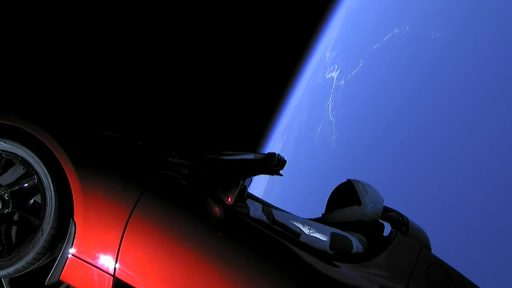
A second burn executed at T+28.5 minutes fired the MVac engine for 30 seconds to accelerate the stack into an elliptical transfer orbit of 180 by 6,951 Kilometers, 29° for two orbits of coasting around Earth to demonstrate a typical 5.5-hour coast phase needed in a direct flight to Geostationary Orbit. SpaceX provided live views of the Roadster and Starman for the majority of the vehicle’s trek around the planet, showing Earth visibly shrink in size as the vehicle reached the high point of its orbit.
For Tuesday’s mission, the second stage was fitted with additional batteries and loaded with more Nitrogen attitude control system propellant to support the lengthy coast duration and the required attitude maneuvers for thermal control and propellant settling. The Earth Departure Maneuver by the second stage is expected around 3 UTC to increase Tesla’s top speed to 11 Kilometers per second and send the combined stack into a Heliocentric Orbit venturing out just beyond the orbit of Mars.
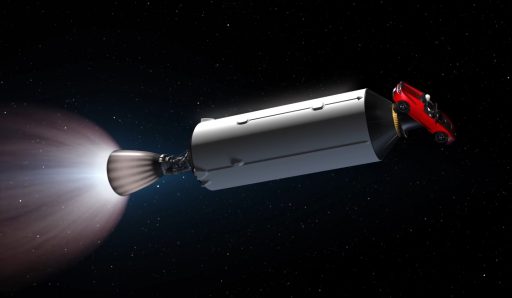
Also traveling alongside the Tesla is a commemorative plate with over 6,000 employee names from SpaceX and an “Arch” 5D, laser-optical quartz storage device meant to survive the harsh conditions of space over millions of years. Built by the Arch Mission Foundation, the device contains Isaac Asimov’s Foundation book series and is launched under the greater goal of preserving libraries of human knowledge, in part inspired by Asimov’s novels themselves.
For Falcon Heavy, Tuesday’s milestone launch marked only the beginning, now ready to carry non-novelty payloads into space and currently planning two more launches in 2018 with the Air Force Space Test Program Flight 2 carrying as many as 20 satellites and targeting a tentative launch date in June and the Arabsat 6A communications satellite marking the rocket’s first Geotransfer mission.
With Falcon 9 Block 5 – the final iteration of the workhorse launcher – almost ready for its debut, Dragon 2 in a final design & testing phase and Falcon Heavy lifting off the drawing board, SpaceX is now free to focus all its development resources on the BFR – Big Falcon Rocket, the company’s ultimate vehicle for human colonization of our neighborhood in the Solar System. Elon Musk – as always optimistic when it comes to schedules – noted initial short-hop missions of an Interplanetary Spaceship prototype could start as early as next year and orbital test flights of the vehicle may only be three or four years out.

